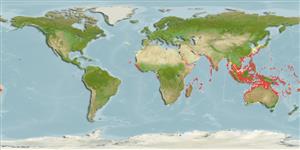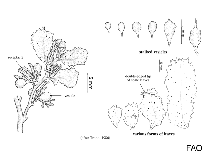Sargassum polycystum C. Agardh
Rough-stemmed sargassum| Native range | All suitable habitat | Point map | Year 2050 |

|
| This map was computer-generated and has not yet been reviewed. |
| Sargassum polycystum AquaMaps Data sources: GBIF OBIS |
Upload your photos
Google image | No image available for this species;
drawing shows typical species in Sargassaceae.
Google image | No image available for this species;
drawing shows typical species in Sargassaceae.
Classification / Names Common names | Synonyms | CoL | ITIS | WoRMS
Phaeophyceae | Fucales | Sargassaceae
Environment: milieu / climate zone / depth range / distribution range Ecology
Sessile; depth range 0 - 63 m (Ref. 102119). Tropical
Distribution Countries | FAO areas | Ecosystems | Occurrences | Introductions
Atlantic and Indo-Pacific oceans: Canary Islands; from Kenya to Madagascar, including Seychelles and Mauritius, east to India and south to Indonesia, including Bay of Bengal and Andaman Islands; from China to the South China Sea, south to Australia, including Xisha Islands, Guam, Northern Mariana Islands, Federated States of Micronesia, New Caledonia, Tonga and Fiji.
Length at first maturity / Size / Weight / Age
Maturity: Lm ? range ? - ? cm
Short description Morphology
Thalli large, dark brown to yellowish brown, attached to rocks by a coarse branching holdfast; stem short cylindrical. Primary branches terete, bearing irregularly alternate secondary branches with numerous simple and Y-shaped proliferations. Mature thalli with fewer and smaller oblanceolate leaves, 7 to 15 mm long and 1.5 to 4 mm wide, with coarsely dentate or serrated margins; midrib prominent up to near the apex. Cryptostomata scattered on the surface of leaves. Stalked vesicles ovate or spherical, numerous; vesicles attached to the secondary, tertiary and terminal branches either singly or in clusters, 1.0 to 2.5 mm in diameter, bearing few cryptostomata and/or teeth-like structures. Plant dioecious. Male receptacles racemose-paniculate, receptacular branches terete, warty. Female receptacles small, cymose; receptacular branches short, dense, compressed, simple or forked with teeth or spines at margins. Thalli up to 40 cm in height (Ref. 80758).
Used as fertilizer, as human food, fodder and medicine; contains auxin-like substance; controls heavy metal (Pb, Cd) pollution; also a source of alginate; may form dense stands and is therefore considered as a good biomass source for biogas production; used as soil fertilizer (Ref. 80758). Usually thrives in inner reef areas on coarse, sandy coralline substrate, not exposed to strong water turbulence (Ref. 80758).
Life cycle and mating behavior Maturity | Reproduction | Spawning | Eggs | Fecundity | Larvae
Main reference
References | Coordinator | Collaborators
Guiry, M.D. and G.M. Guiry. 2009. (Ref. 80701)
IUCN Red List Status (Ref. 130435)
CITES status (Ref. 108899)
Not Evaluated
CMS (Ref. 116361)
Not Evaluated
Threat to humans
Harmless (Ref. 80758)
Human uses
Fisheries: commercial
| FishSource |
Tools
More information
Internet sources
BHL | BOLD Systems | CISTI | DiscoverLife | FAO(Publication : search) | Fishipedia | GenBank (genome, nucleotide) | GloBI | Gomexsi | Google Books | Google Scholar | Google | PubMed | AlgaeBase | Tree of Life | Wikipedia (Go, Search) | Zoological Record
Estimates based on models
Preferred temperature
(Ref. 115969): 23.8 - 29.1, mean 28 (based on 1868 cells).



